Saturn is well known for its ring system and many recognise that the planets Jupiter, Uranus and Neptune also have rings. Did Earth ever have rings though? A team of researchers suggests that a worldwide collection of impact craters points to the existence of a ring around Earth millions of years ago. It’s possible that Earth captured and destroyed an asteroid that passed too close 466 million years ago. The asteroids torn up debris orbited the Earth as a ring and then the individual chunks entered the atmosphere, landed on the surface and produced the craters observed today.
Continue reading “Earth Might Have Had Rings Half a Billion Years Ago”Uranus’ Rings are Surprisingly Bright in Thermal Emissions
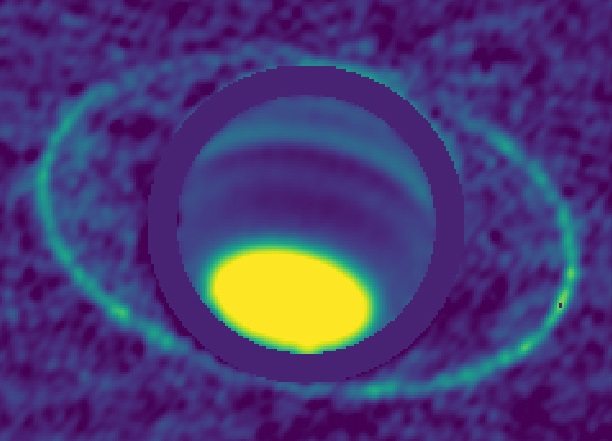
During the late 1970s, scientists made a rather interesting discovery about the gas giants of the Solar System. Thanks to ongoing observations using improved optics, it was revealed that gas giants like Uranus – and not just Saturn – have ring systems about them. The main difference is, these ring systems are not easily visible from a distance using conventional optics and require exceptional timing to see light being reflected off of them.
Another way to study them is to observe their planet in infrared or radio wavelengths. This was recently demonstrated by a team of astronomers who conducted observations of Uranus using the Atacama Large Millimeter/submillimeter Array (ALMA) and the Very Large Telescope (VLT). In addition to obtaining temperature readings from the rings, they confirmed what many scientists have suspected about them for some time.
Continue reading “Uranus’ Rings are Surprisingly Bright in Thermal Emissions”Beautiful Planetary Rings Are Dead Dwarf Planets! Dead Dwarf Planets!!!
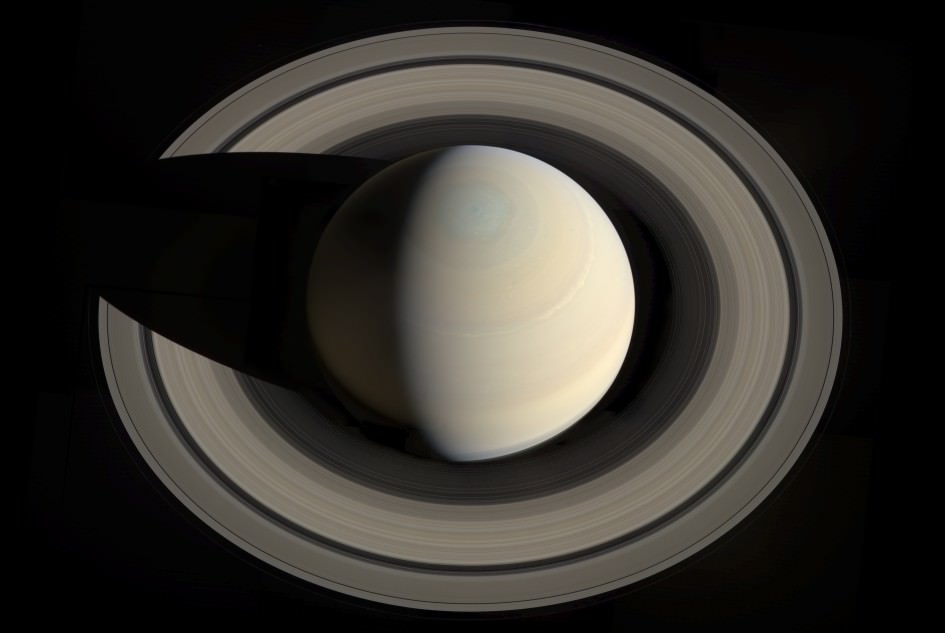
In 1655, astronomer Christiaan Huygens became the first person to observe the beautiful ring system that surrounds Saturn. And while they are certainly the most spectacular, astronomers have since discovered that all the gas and ice giants of the Solar System (i.e. Jupiter, Saturn, Uranus and Neptune) have their own system of rings.
These systems have remained a source of fascination for astronomers, largely because their origins are still something of a mystery. But thanks to a recent study by researchers from the Tokyo Institute of Technology and Kobe University, the origins of these rings may be solved. According to their study, the rings are pieces of Dwarf Planets that got torn off in passing, which were then ripped to pieces!
This research could help to resolve many of the burning questions about the ring systems around our system’s giant planets, as well as details about the Solar Systems past. For the sake of their study – titled “Ring Formation around Giant Planets by Tidal Disruption of a Single Passing Large Kuiper Belt Object” – the Japanese team of researchers considered a number of factors.
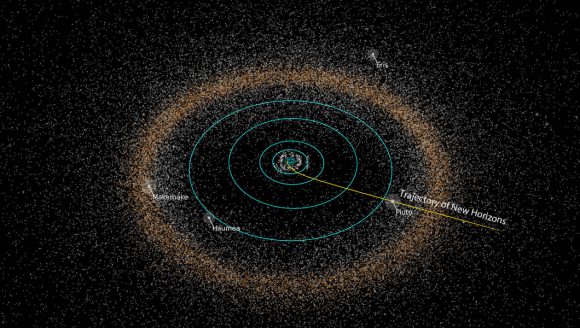
First, they considered the diversity of the various ring systems in our Solar System. For instance, Saturn’s rings are massive (about 100,000 trillion kg!) and composed overwhelmingly (90-95%) of water ice. In contrast, the much less massive rings of Uranus and Neptune are composed of darker material, and are believed to have higher percentages of rocky material in them.
To shed some light on this, the team looked to the Nice Model – a theory of Solar System formation that states that the gas giant migrated to their present location during the Late Heavy Bombardment. This period took place between 4 and 3.8 billion years ago, and was characterized by a disproportionately high number of asteroids from Trans-Neptunian space striking planets in the Inner Solar System.
They then considered other recent models of Solar System formation which postulate that the giant planets experienced close encounters with Pluto-sized objects during this time. From this, they developed the theory that the rings could be the result of some of these objects getting trapped and ripped apart by the gas giants’ gravity. To test this theory, they performed a number of computer simulations to see what would happen in these instances.
As Ryuki Hyodo – a researcher at the Department of Planetology, Kobe University, and the lead author on the paper – told Universe Today via email:
“We performed two simulations. First, using SPH (Smoothed-particle hydrodynamics) simulations, we investigated tidal disruption of Pluto-sized objects during the close encounters with giant planets and calculated the amount of fragments that are captured around giant planets. We found enough mass/fragments to explain current rings is captured. Then, we performed the longer-term evolution of the captured mass/fragments by using N-body simulations. We found that the captured fragments can collide each other with destruction and form thin equatorial circular rings around giant planets.”
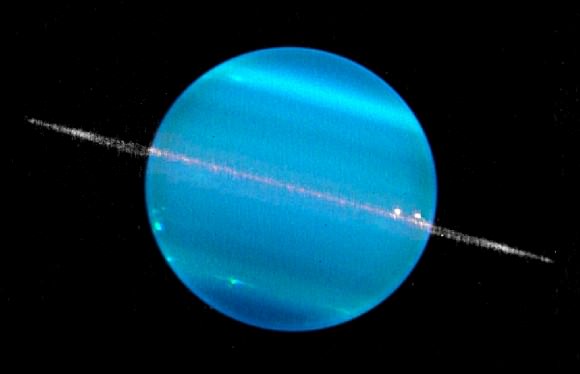
The results of these simulation were consistent with the mass of the ring systems observed around Saturn and Uranus. This included the inner regular satellites of both planets – which would have also been the product of the past encounters with KBOs. It also accounted for the differences in the rings’ composition, showing how the planet’s Roche limits can influence what kind of material can be effectively captured.
This study is especially significant because it offers verifiable evidence for one of the enduring mysteries of our Solar System. And as Hyodo points out, it could come in mighty handy when it comes time to examine extra-solar planetary systems as well.
“Our theory suggested that, in the past, we had two possible epochs to form rings,” he said. “One is during the planet accretion phase and the other is during the Late heavy bombardment. Also, our model is naturally applicable to other planetary systems. So, our theory predicts that exoplanets also have massive rings around them.”
In the meantime, some might find the idea that ring systems are the corpses of Dwarf Planets troublesome. But I think we can all agree, a Soylent Green allusion might be just a bit over the top!
Further Reading: arXiv
An Exoplanet With Huge Rings Intrigues
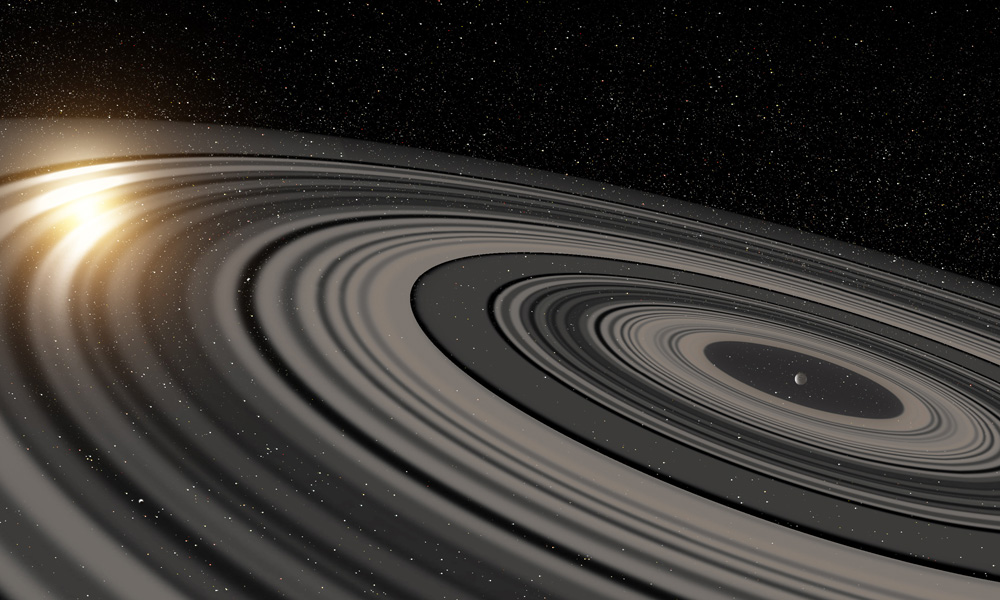
Back in 2007, astronomers observed a series of unusual eclipses coming from a star 420 light years from Earth. In 2012, a team from Japan and the Netherlands reasoned that this phenomena was due to the presence of a large exoplanet – designated J1407b – with a massive ring system orbiting the star. Since then, several surprising finds have been made.
For example, in 2015, the same team concluded that the ring system is one-hundred times larger and heavier than Saturn’s (and may be similarly sculpted by exomoons). And in their most recent study, they have shown that these giant rings may last for over 100,000 years, assuming they have a rare and unusual orbit around their planet.
In their previous work, Rieder and Kenworth determined that the ring system around J1407b consisted about 37 rings that extend to a distance of 0.6 AU (90 million km) from the planet. They also estimated that these rings are 100 times as massive as our Moon – 7342 trillion trillion metric tons. What’s more, while J1407b’s existence is yet to be confirmed, they were able to rule out the possibility of it having a circular orbit around the star.
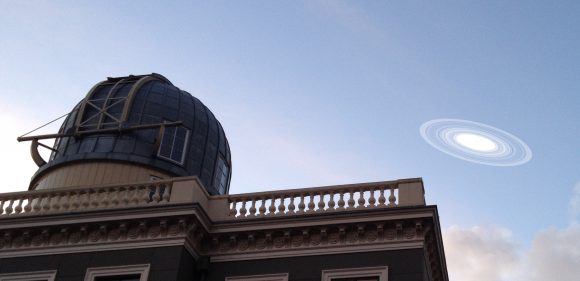
As a result, there were doubts that such a ring system could exist. Given the fact that the planet periodically gets closer to its star, the ring system would experience gravitational disruption. Therefore, Steven Rieder (of the RIKEN institute in Japan) and Matthew Kenworth (of Leiden University in the Netherlands) set out to assess how long such a ring system could remain stable for.
For the sake of their study, titled “Constraints on the Size and Dynamics of the J1407b Ring System“, they conducted a series of simulations using the Astrophysical Multi-purpose Software Environment (AMUSE) framework. In the end, their results showed that a ring structure with an 11 year orbital period and a retrograde orbit could survive for at least 10,000 orbits.
In other words, the ring system that they hypothesized back in 2012 could endure for 110,000 years. As Rieder (the lead author on the paper) explained in a statement, the results were surprising, but happened to fit the facts:
“The system is only stable when the rings rotate opposite to how the planet orbits the star. It might be far-fetched: massive rings that rotate in opposite direction, but we now have calculated that a ‘normal’ ring system cannot survive.”
How such a ring system could have come about is a mystery, as retrograde ring systems are quite uncommon. But Rieder and Kenworth have stated that they think it might be the result of a catastrophic event – such as a massive collision – that caused the rings (or the planet) to change the direction of their rotation.
Their results also indicated that a retrograde ring system would allow for eclipses, like the one that was observed in 2007. While there was some chance of these being caused by another object, the results suggested otherwise. “The chance of that is minimal,” said Rieder. “Also, the velocity measured with previous observations may not be right, but that would be very strange, because those measurements are very accurate.”
In the future, Rieder and Kenswoth hope to investigate the mysteries of this ring formation more closely. This will include how it could have formed in the first place, and how it has evolved over time. Their study has been accepted for publication in the journal Astronomy & Astrophysics and be viewed online at arXiv.
Further Reading: astronomie.nl, arXiv
Centaurs Keep Their Rings From Greedy Gas Giants
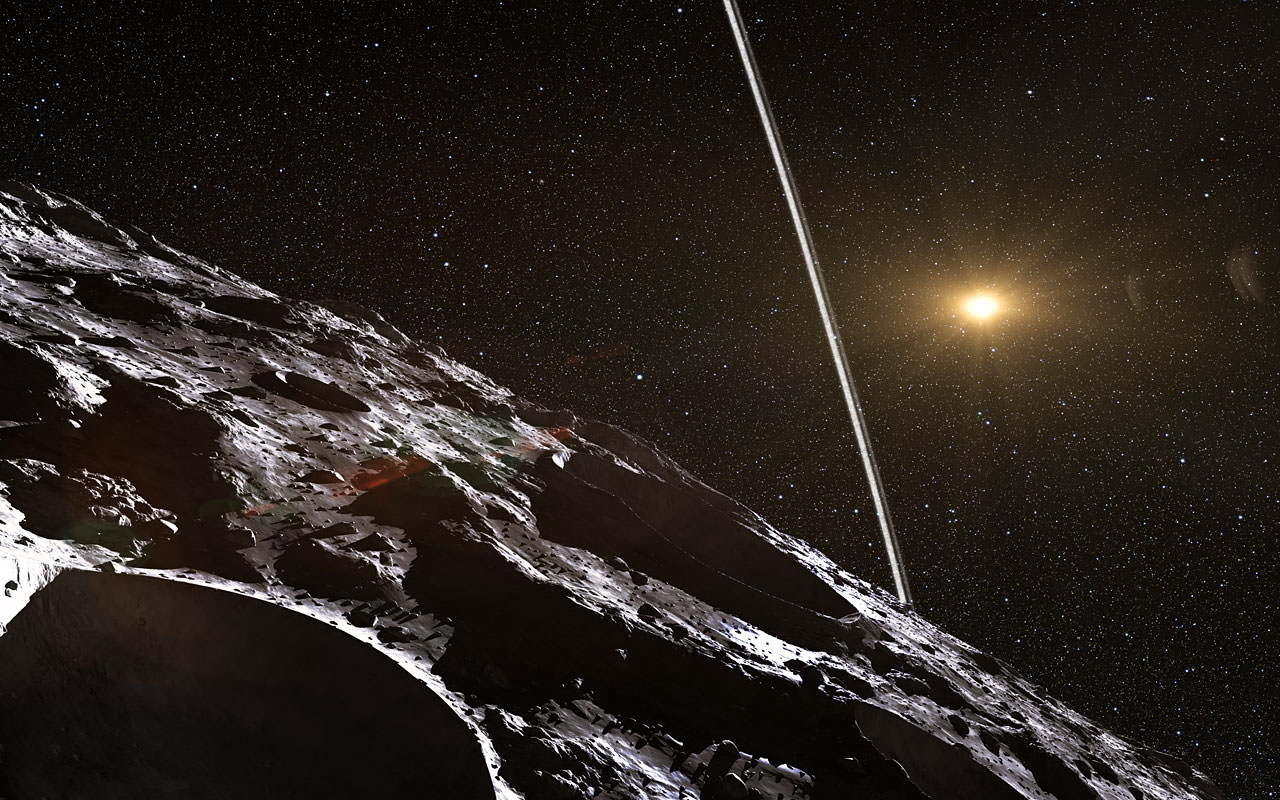
When we think of ring systems, what naturally comes to mind are planets like Saturn. It’s beautiful rings are certainly the most well known, but they are not the only planet in our Solar System to have them. As the Voyager missions demonstrated, every planet in the outer Solar System – from Jupiter to Neptune – has its own system of rings. And in recent years, astronomers have discovered that even certain minor planets – like the Centaur asteroids 10199 Chariklo and 2006 Chiron – have them too.
This was a rather surprising find, since these objects have such chaotic orbits. Given that their paths through the Solar System are frequently altered by the powerful gravity of gas giants, astronomers have naturally wondered how a minor planet could retain a system of rings. But thanks to a team of researchers from the Sao Paulo State University in Brazil, we may be close to answering that question.
In a study titled “The Rings of Chariklo Under Close Encounters With The Giant Planets“, which appeared recently in The Astrophysical Journal, they explained how they constructed a model of the Solar System that incorporated 729 simulated objects. All of these objects were the same size as Chariklo and had their own system of rings. They then went about the process of examining how interacting with gas giant effected them.
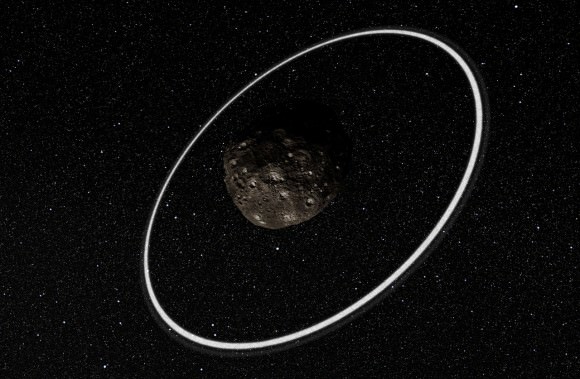
To break it down, Centaurs are a population of objects within our Solar System that behave as both comets and asteroids (hence why they are named after the hybrid beasts of Greek mythology). 10199 Chariklo is the largest known member of the Centaur population, a possible former Trans-Neptunian Object (TNO) which currently orbits between Saturn and Uranus.
The rings around this asteroid were first noticed in 2013 when the asteroid underwent a stellar occultation. This revealed a system of two rings, with a radius of 391 and 405 km and widths of about 7 km 3 km, respectively. The absorption features of the rings showed that they were partially composed of water ice. In this respect, they were much like the rings of Jupiter, Saturn, Uranus and the other gas giants, which are composed largely of water ice and dust.
This was followed by findings made in 2015 that indicated that 2006 Chiron – another major Centaur – could have a ring of its own. This led to further speculation that there might be many minor planets in our Solar System that have a system of rings. Naturally, this was a bit perplexing to astronomers, since rings are fragile structures that were thought to be exclusive to the gas giants of our System.
As Professor Othon Winter, the lead researcher of the Sao Paulo team, told Universe Today via email:
“At first it was a surprise to find a Centaur with rings, since the Centaurs have chaotic orbits wandering between the giant planets and having frequent close encounters with them. However, we have shown that in most of the cases the ring system can survive all the close encounters with the giant planets. Therefore, Centaurs with rings might be much more common than we thought before.”
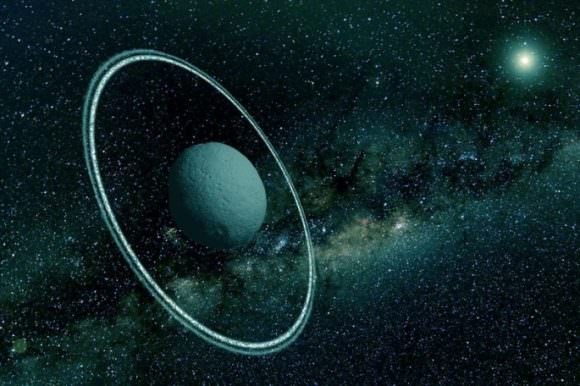
For the sake of their study, Winter and his colleagues considered the orbits of 729 simulated clones of Chariklo as they orbited the Sun over the course of 100 million years. From this, Winter and his colleagues found that each Centaur averaged about 150 close encounters with a gas giant, within one Hill radius of the planet in question. As Winter described it:
“The study was made in two steps. First we considered a set of more than 700 clones of Chariklo. The clones had initial trajectories that were slightly different from Chariklo for statistical purposes (since we are dealing with chaotic trajectories) and computationally simulated their orbital evolution forward in time (to see their future) and also backward in time (to see their past). During these simulations we archived the information of all the close encounters (many thousands) they had with each of the giant planets.”
“In the second step, we performed simulations of each one of the close encounters found in the first step, but now including a disk of particles around Chariklo (representing the ring particles). Then, at the end of each simulation we analyzed what happened to the particles. Which ones were removed from Chariklo (escaping its gravitational field)? Which ones were strongly disturbed (still orbiting around Chariklo)? Which ones did not suffer any significant effect?”
In the end, the simulations showed that in 90 percent of the cases, the rings of the Centaurs survived their close encounters with gas giants, whereas they were disturbed in 4 percent of cases, and were stripped away only 3 percent of the time. Thus, they concluded that if there is an efficient mechanism that creates the rings, then it is strong enough to let Centaurs keep them.
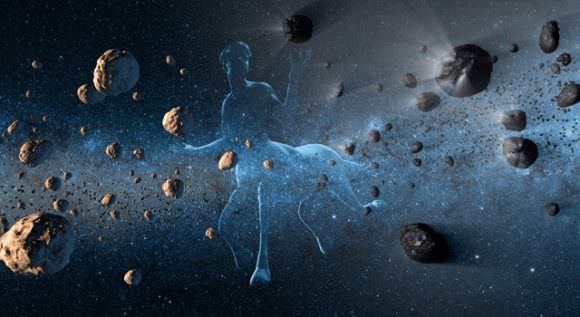
More than that, their research would seem to indicate that what was considered unique to certain planetary bodies may actually be more commonplace. “It reveals that our Solar System is complex not just as whole or for large bodies,” said Winter, “but even small bodies may show complex structures and even more complex temporal evolution.”
The next step for the research team is to study ring formation, which could show that they in fact picking them up from the gas giants themselves. But regardless of where they come from, its becoming increasingly clear that Centaurs like 10199 Chariklo are not alone. What’s more, they aren’t giving up their rings anytime soon!
Further Reading: iopscience.iop.org
Outer Space – Mind Blowing Video from Jupiter and Saturn
Video Caption: This mesmerizing video unveils incredibly amazing sequences around Jupiter and Saturn from NASA’s Cassini and Voyager missions set to stirring music by “The Cinematic Orchestra -That Home (Instrumental)”. Credit: Sander van den Berg
Don’t hesitate 1 moment ! Look and listen to this mind blowing video of the Jupiter and Saturnian systems.
If you love the wonders of the hitherto unknown Universe unveiled before your eyes – and long to explore – feast your eyes on this short new video right now titled simply; “Outer Space”. Continue reading “Outer Space – Mind Blowing Video from Jupiter and Saturn”

